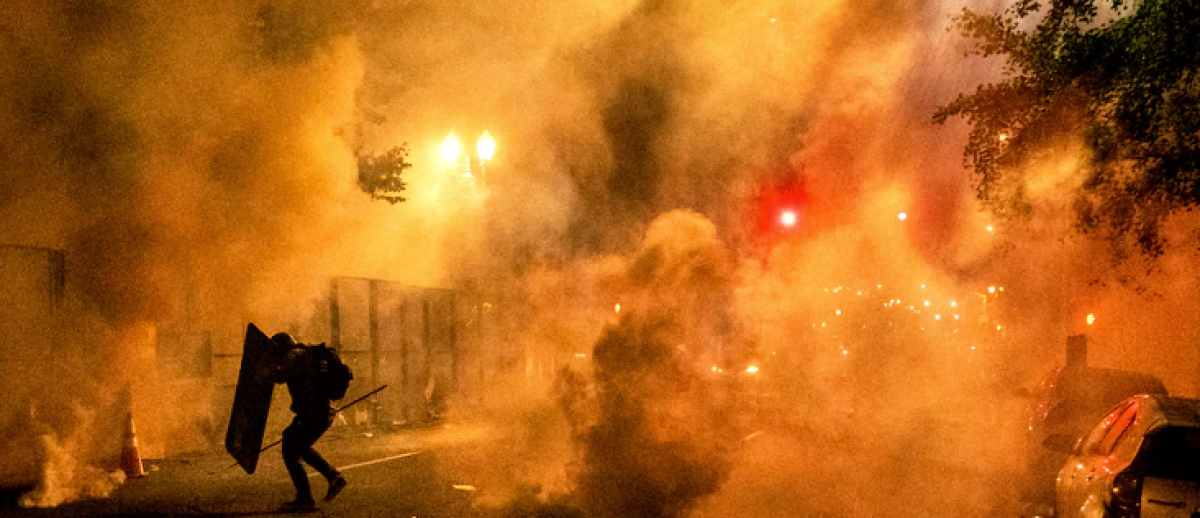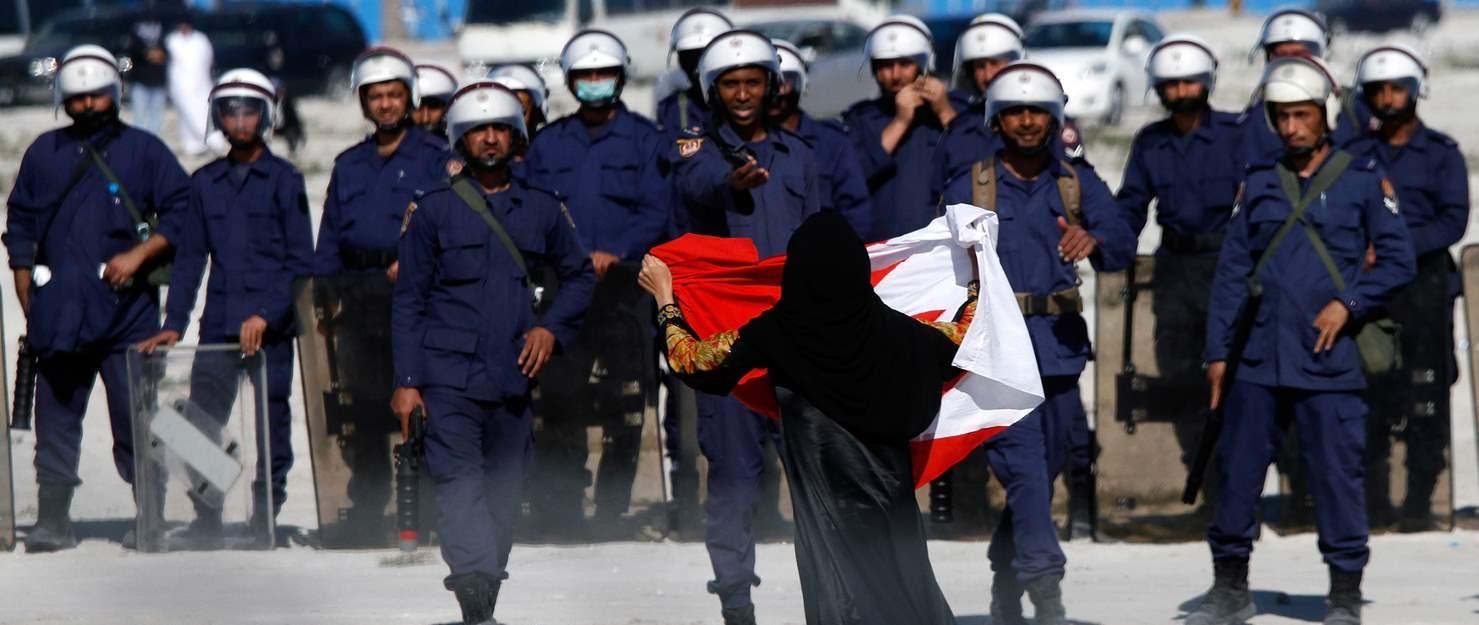The War on Terror Paradigm and Intersecting Contemporary Civil Uprisings
archive


2020 Black Lives Matter protester in Portland, Oregon. (Image credit: Noah Berger Photography)
The War on Terror Paradigm and Intersecting Contemporary Civil Uprisings
In the past decade, protests have erupted across the world in separate and seemingly isolated contexts. While different in cause and organization, what these global mass-uprisings have in common are the ways they were met with “legal” violence at the hands of the ruling elite. To contextualize their intersections and continuities of power and counterpower, we focus on repressive state responses to the Middle East and Black Lives Matter (BLM) protests in the 2010s and 2020 respectively, grounding these responses within the theoretical framework of the War on Terror Paradigm (WTP) to argue for the global interconnections of repression.
The War on Terror Paradigm (WTP) refers to the legitimization and implementation of a violence and warfare which ignores and reinterprets International Humanitarian Laws, namely the 1949 Geneva Conventions. Lisa Hajjar, who coined the term, argues that the United States developed the WTP as a result of the September 11, 2001 terrorist attacks. The main elements of the paradigm, which have had significant impacts on the reinterpretation of what is “legal” in warfare, are 1) the “rightlessness” of stateless enemies, 2) justification of violence through judicial logic, and 3) a global influence in other countries responses to opposition.1 These conceptual shifts within WTP have been adopted as policies, rationalized and justified by being framed as “national security” concerns. Ultimately, WTP synthesizes these qualitatively new features of 21st century warfare and provides a language to contextualize, identify, and transgress such policies and actions.
WTP continues to be extremely relevant today in a global moment characterized by a rise of authoritarianism. Internationally, it legitimated the militarization of national police forces by rendering dissent as a threat to “national security” in non-democratic states across the Middle East in the 2010s. Within the United States, it has been deployed against the BLM protests, providing cover for overt state repression against a new national “enemy,” one that is oftentimes labeled as not-peaceful, left-wing extremist, anarchist, and a threat to property.
National Security: A Global Obsession
The obsession with national security begs the question, from whom we are defending the nation and whom does security serve? How has citizens' criticism of the state been interpreted and framed as aggression and terror? These questions are at the center of discussions when it comes to dissent and protest in authoritarian states.
In the 2010s, the Middle East experienced a wave of social movements and civil mass-uprisings in protest to authoritarianism, police brutality, corruption, and poor economic conditions. Protests erupted in Tunisia, Egypt, Libya, Yemen, Syria, Iran, Bahrain, Turkey, and Iraq. These popular uprisings were interpreted by the ruling elite as a threat to national security, realizing that their hegemonic control was being called into question. While largely peaceful, the protesters were met with anti-riot police, water cannons, teargas, and rubber bullets. The streets, which were once vibrant urban public spaces, became battlefields as repressive state actors had “authorization for use of military force” against their own nationals.2 Applying the logics of combat, in Iran, detainees were taken to undisclosed locations, tortured, and forced to give confessions without access to legal representation or contact with their families.3 Here, Iran provides an example of a national implementation of international actions legalized by the U.S. Congress through the Military Commissions Act, “which reinstituted the commissions and gave legislative sanction for the use of hearsay and of evidence elicited through coercive means.”4
At the ideological level in the Middle East, the ruling elite used divisive language, labeling dissidents as marauders, terrorists, seditionists, and foreign agents to demean their movements and discredit their demands. In particular, the label “foreign actor” positioned the protesters as stateless through a linkage with the diaspora and the Global North. Given this apparent connection, severing this ‘influence’ was deemed necessary for national security. Thus, some of the abovementioned states shut down internet access which consequently prevented the real time circulation of proof of police brutality and violent repression. As a result of controlled communication with an international audience, these states were then able to carry out extrajudicial processes legitimized through federal policies. In Turkey and Egypt, government officials carried out nationwide investigations and targeted imprisonments based on the data collected from mass-surveillance apparatuses. Both of these examples reflect similar situations as those enacted in the post 9/11 United States, such as the National Security Agency’s global monitoring of communications networks. These actions in the Middle East demonstrate how the original implications of WTP have taken root transnationally and internationally. Interestingly, it appears this logic has come full circle, as revealed in the 2020 Black Lives Matter protests.
The War on BLM
In the United States, the onset of the 2020 BLM protests in general and those in Portland, Oregon in particular have demonstrated the power of collective direct action, and consequently revealed the repressive hand of the authoritarian state. Anti-racist solidarity protests and demonstrations erupted worldwide in May 2020 in response to the racist murder of George Floyd at the hands of police officers in Minneapolis, Minnesota. While protests continued to occur across the nation, the demonstrations in Portland received major attention because of their longevity and magnitude, which materialized into confrontation with federal forces.
The obsession with national security begs the question, from whom we are defending the nation and whom does security serve?
These protests led U.S. president Donald Trump to deploy federal forces via “Operation Diligent Valor” with the aim to protect federal property from real and perceived threats of destruction. Specifically, the Department of Homeland Security (DHS) was authorized to quell the protests by “anarchist and left-wing extremists.” It is important to note that the DHS was created after 9/11 to “protect the country against external threats,” though today it is mostly utilized to terrorize undocumented communities.5 Under the guise of “public safety and national survival,” Portland became a militarized site with unlawful abductions and violent beating of protesters by government agents. These illegal seizures against domestic protesters followed a logic integral to the CIA’s international practice of “disappearing” people, part of its rendition, detention, and interrogation program. Such actions were legitimized by the 2005 Detainee Treatment Act that sought to “circumscribe the habeas protection... as well as to foreclose any avenue for judicial enforcement of the ban on cruel treatment.”6 The WTP reminds us that interventions such as these in Portland are deemed “legitimate” because the state’s enemy is “essentially rightless and thus could be subjected to any form of violence.”7
The BLM example demonstrates how dissent anchored in Black liberation is quickly delegitimized when actions threaten the foundation of the institutions that uphold the “imperialist white supremacist capitalist patriarchy” system of domination.8 In particular, the destruction of property and the call to defund the police illustrates politics that exists outside of the hegemonic logic of legality, a logic which has historically stunted systematic threats. The WTP comes back full circle as the policies and practices once issued against an external enemy are now being used domestically, including “fabrication of war crimes” to justify violence against citizens who exercise their democratic right to protest.9

Security forces in Bahrain move on protestors during the spring 2011 uprisings. (Photo credit: John Moore/Getty Images via Amnesty International)
The deployment of federal agents to militantly control dissent reflects a rise of authoritarian governance in the United States, a practice not unique to any single country as shown above. It is important to view the WTP as an analytical abstraction to understand how seemingly disparate circumstances legitimize how the state has framed protesters as an “enemy” who perpetuates chaos and threatens a nation's security.
Global Intersections of Power
These examples are connected within a 21st century historical moment characterized by rising authoritarianism and worldwide protests against the trickling violent repercussions of neoliberalism. As we have stressed in this article, it is important to identify the historical judicial and extrajudicial conditions that have facilitated this moment. Ultimately, the WTP provides a framework to understand how power operates in concept and form, helping to name the contemporary moment as well as the policies and practices that flow globally to legalize a status quo. The identification of this interconnection is crucial to the study of similarities in social justice struggles around the world.
Our focus on the Middle East and Portland, Oregon is an exploratory case study that demonstrates the applicability of the WTP as a means to identify the intersections of transnational, national, and temporally different contexts. We hope that these ruminations on the issues of legitimization of violence and the use of extrajudicial processes encourage fellow scholars and activists from around the world to contribute10 to a conversation on global flows of emancipation and humanitarian understanding.
Authors’ note:
This essay grows out of the “Transnationalizing the Study of the United States” research cluster of the Orfalea Center for Global & International Studies at the University of California, Santa Barbara. The cluster explores how the United States is positioned as the object of study from the perspective of other states, non-state actors, and transnational organizations in the Global South. This piece aims to serve as a springboard for research centers, activists, and intellectuals to be part of a transnational conversation about contemporary power struggles and humanitarian solutions to negate the repressive implications of the WTP in diverse geographical and epistemological contexts.
1. Lisa Hajjar. “The Counterterrorism War Paradigm versus International Humanitarian Law: The Legal Contradictions and Global Consequences of the US ‘War on Terror.’” Law and Social Inquiry 444, no. 4 (2019): 923-4.
2. Hajjar: 922.
3. Yassamine Mather. “Iran’s Political and Economic Crises.” Critique 38, no. 3 (2010): 510.
4. Hajjar: 935.
5. Tanya Maria Golash-Boza. Immigration Nation: Raids, Detentions, and Deportations in Post-9/11 America. (New York: Routledge, 2015).
6. Hajjar: 935.
7. Hajjar: 931.
8. bell hooks. Belonging: A Culture of Place. (New York: Routledge, 2009): 20.
9. Hajjar: 937.
10. In fact, we plan to create a journal series that encourages submissions on the WTP to write about the following areas: 1) implication of Trump-era policies in the global south, 2) WTP at a localized level within and beyond the United States, 3) the ways resistance to oppression has been interlinked with the label “terrorist” in the eyes of state actors and 4) a meditation on who profits and funds the logics and policies central to a WTP?




